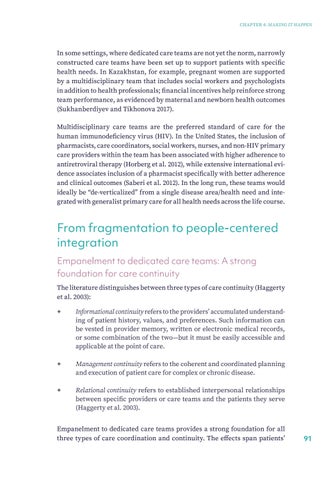CHAPTER 4: MAKING IT HAPPEN
In some settings, where dedicated care teams are not yet the norm, narrowly constructed care teams have been set up to support patients with specific health needs. In Kazakhstan, for example, pregnant women are supported by a multidisciplinary team that includes social workers and psychologists in addition to health professionals; financial incentives help reinforce strong team performance, as evidenced by maternal and newborn health outcomes (Sukhanberdiyev and Tikhonova 2017). Multidisciplinary care teams are the preferred standard of care for the human immunodeficiency virus (HIV). In the United States, the inclusion of pharmacists, care coordinators, social workers, nurses, and non-HIV primary care providers within the team has been associated with higher adherence to antiretroviral therapy (Horberg et al. 2012), while extensive international evidence associates inclusion of a pharmacist specifically with better adherence and clinical outcomes (Saberi et al. 2012). In the long run, these teams would ideally be “de-verticalized” from a single disease area/health need and integrated with generalist primary care for all health needs across the life course.
From fragmentation to people-centered integration Empanelment to dedicated care teams: A strong foundation for care continuity The literature distinguishes between three types of care continuity (Haggerty et al. 2003): ++
Informational continuity refers to the providers’ accumulated understanding of patient history, values, and preferences. Such information can be vested in provider memory, written or electronic medical records, or some combination of the two—but it must be easily accessible and applicable at the point of care.
++
Management continuity refers to the coherent and coordinated planning and execution of patient care for complex or chronic disease.
++
Relational continuity refers to established interpersonal relationships between specific providers or care teams and the patients they serve (Haggerty et al. 2003).
Empanelment to dedicated care teams provides a strong foundation for all three types of care coordination and continuity. The effects span patients’
91


